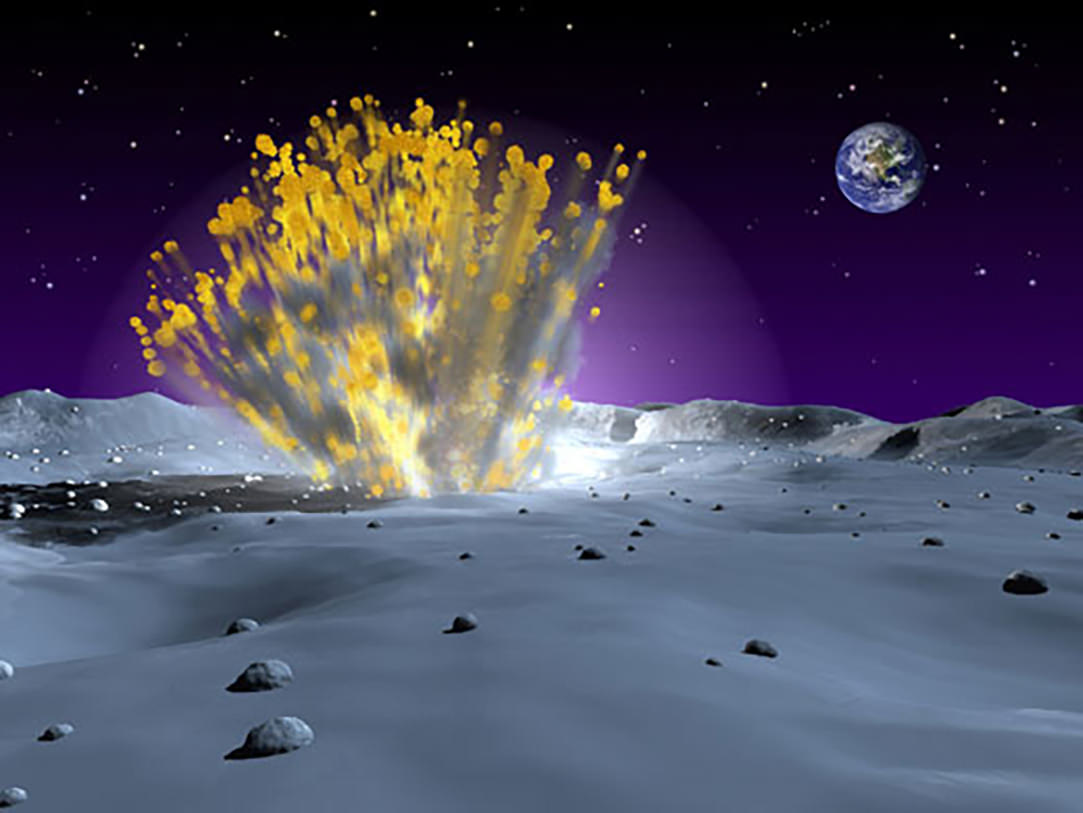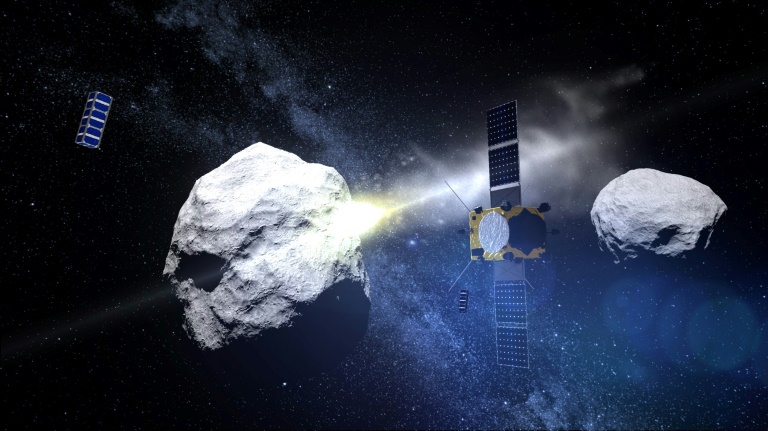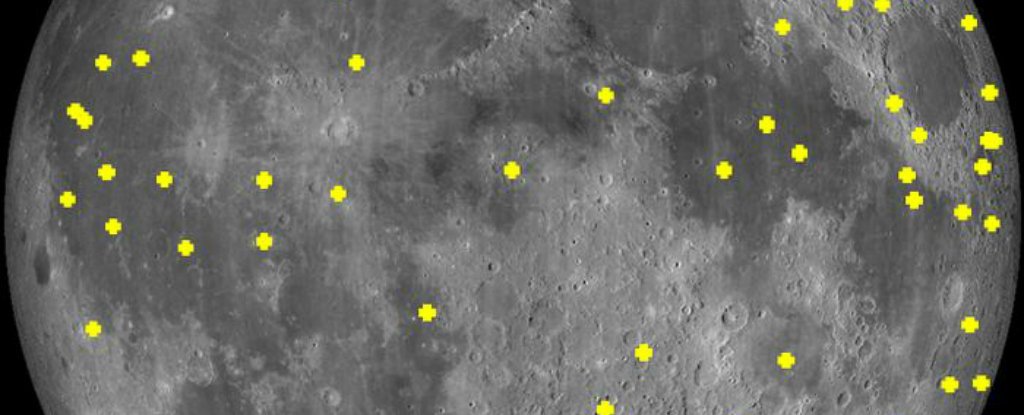ΣΧΟΛΙΟ ΙΣΤΟΛΟΓΙΟΥ : Δεν μπορούν να παίζουν με τα φώτα τους οι "άνθρωποι";; Αμέσως εμείς να τους μαρτυρήσουμε.!! Μπα σε καλό μας...μόνο στην Γη νομίζεται είναι φωτιά και λάβρα η Δ.Ε.Ηθώμεν;;;Και εκεί τα μαλλιά της κεφαλής τους πληρώνουνε στους εκεί νταβάδες.
Ever since the Apollo missions explored the lunar surface, scientists have known that the Moon's craters are the result of a long history of meteor and asteroid impacts. But it has only been in the past few decades that we have come to understand how regular these are.
In fact, every few hours, an impact on the lunar surface is indicated by a bright flash. These impact flashes are designed as a "transient lunar phenomena" because they are fleeting.
Basically, this means that the flashes (while common) last for only a fraction of a second, making them very difficult to detect. For this reason, the European Space Agency (ESA) created the NEO Lunar Impacts and Optical TrAnsients (NELIOTA) project in 2015 to monitor the moon for signs of impact flashes.
By studying them, the project hopes to learn more about the size and distribution of near-Earth objects to determine if they pose a risk to Earth.
To be fair, this phenomena is not new to astronomers, as flashes have been reportedly seen lighting up dark sections of the Moon for at least a thousand years.
It has only been recently, however, that scientists have had telescopes and cameras sophisticated enough to observe these events and characterize them (i.e. size, speed and frequency).
 (NASA/Jennifer Harbaugh)
(NASA/Jennifer Harbaugh)
Determining how often such events take place, and what they can teach us about our Near-Earth environment is the reason the ESA created NELIOTA.
In February of 2017, the project began a 22 month-long campaign to observe the Moon using the 1.2 m telescope at the Kryoneri Observatory located in Greece. This telescope is the largest instrument on Earth ever dedicated to monitoring the Moon.
In addition, the NELIOTA system is the first to use a 1.2
m-telescope for monitoring the Moon. Traditionally, lunar monitoring
programs have relied on telescopes with primary mirrors measuring 0.5 m
in diameter or smaller.
The larger mirror of the Kryoneri telescope allows the NELIOTA scientists to detect flashes two magnitudes fainter than other lunar monitoring programs.
But even with the right instruments, detecting these flashes is no easy task. In addition to lasting for only a fraction of a second, it is also impossible to spot them on the bright side of the Moon since the sunlight reflected from the surface is much brighter.
For this reason, these events can only be seen on the Moon's "dark side" – i.e. between a New Moon and First Quarter and between a Last Quarter and New Moon.
The Moon must also be above the horizon at the time and observations must be conducted using a fast-frame camera. Because of these necessary conditions, the NELIOTA project has only been able to obtain 90 hours of observation time over a 22-month period, during which time 55 lunar impact events were observed.
From this data, scientists were able to extrapolate that an average of about 8 flashes occur every hour on the surface of the Moon.
 (ESA/AFP)
(ESA/AFP)
Another feature that sets the NELIOTA project apart is its two fast-frame cameras that enable lunar monitoring in the visible and near-infrared bands of the spectrum.
This allowed the project scientists to conduct the first study ever where the temperatures of lunar impacts were calculated. Of the first ten they detected, they obtained temperature estimates ranging from about 1,300 to 2,800 °C ( 2372 to 5072 °F).
With the extension of this observing campaign to 2021, the
NELIOTA scientists hope to obtain further data that will improve impact
statistics.
In turn, this information will go a long way towards addressing the threat of Near-Earth Objects – which consist of asteroids and comets that periodically pass close to Earth (and on rare occasions, impact on the surface).
In the past, the ESA has monitored these objects through its Space Situational Awareness (SSA) program, of which the NELTIOA project is part.
Today, the SSA is building infrastructure in space and on the ground (such as the deployment of Flyeye telescopes across the globe) to improve our monitoring and understanding of potentially hazardous NEOs.
In the future, the ESA plans to transition from monitoring NEOs to developing mitigation and active planetary defense strategies.
This includes the proposed NASA/ESA Hera mission – formerly known as the Asteroid Impact & Deflection Assessment (AIDA) – which is scheduled to launch by 2023.
In the coming decades, other measures (ranging from directed energy and ballistic missiles to solar sails) are also likely to be investigated.
But as always, the key to protecting Earth from future impacts is the existence of effective detection and monitoring strategies. In this respect, projects like NELIOTA will prove to be invaluable.
ΠΗΓΗ
Ever since the Apollo missions explored the lunar surface, scientists have known that the Moon's craters are the result of a long history of meteor and asteroid impacts. But it has only been in the past few decades that we have come to understand how regular these are.
In fact, every few hours, an impact on the lunar surface is indicated by a bright flash. These impact flashes are designed as a "transient lunar phenomena" because they are fleeting.
Basically, this means that the flashes (while common) last for only a fraction of a second, making them very difficult to detect. For this reason, the European Space Agency (ESA) created the NEO Lunar Impacts and Optical TrAnsients (NELIOTA) project in 2015 to monitor the moon for signs of impact flashes.
By studying them, the project hopes to learn more about the size and distribution of near-Earth objects to determine if they pose a risk to Earth.
To be fair, this phenomena is not new to astronomers, as flashes have been reportedly seen lighting up dark sections of the Moon for at least a thousand years.
It has only been recently, however, that scientists have had telescopes and cameras sophisticated enough to observe these events and characterize them (i.e. size, speed and frequency).
 (NASA/Jennifer Harbaugh)
(NASA/Jennifer Harbaugh)Determining how often such events take place, and what they can teach us about our Near-Earth environment is the reason the ESA created NELIOTA.
In February of 2017, the project began a 22 month-long campaign to observe the Moon using the 1.2 m telescope at the Kryoneri Observatory located in Greece. This telescope is the largest instrument on Earth ever dedicated to monitoring the Moon.
The larger mirror of the Kryoneri telescope allows the NELIOTA scientists to detect flashes two magnitudes fainter than other lunar monitoring programs.
But even with the right instruments, detecting these flashes is no easy task. In addition to lasting for only a fraction of a second, it is also impossible to spot them on the bright side of the Moon since the sunlight reflected from the surface is much brighter.
For this reason, these events can only be seen on the Moon's "dark side" – i.e. between a New Moon and First Quarter and between a Last Quarter and New Moon.
The Moon must also be above the horizon at the time and observations must be conducted using a fast-frame camera. Because of these necessary conditions, the NELIOTA project has only been able to obtain 90 hours of observation time over a 22-month period, during which time 55 lunar impact events were observed.
From this data, scientists were able to extrapolate that an average of about 8 flashes occur every hour on the surface of the Moon.
 (ESA/AFP)
(ESA/AFP)Another feature that sets the NELIOTA project apart is its two fast-frame cameras that enable lunar monitoring in the visible and near-infrared bands of the spectrum.
This allowed the project scientists to conduct the first study ever where the temperatures of lunar impacts were calculated. Of the first ten they detected, they obtained temperature estimates ranging from about 1,300 to 2,800 °C ( 2372 to 5072 °F).
In turn, this information will go a long way towards addressing the threat of Near-Earth Objects – which consist of asteroids and comets that periodically pass close to Earth (and on rare occasions, impact on the surface).
In the past, the ESA has monitored these objects through its Space Situational Awareness (SSA) program, of which the NELTIOA project is part.
Today, the SSA is building infrastructure in space and on the ground (such as the deployment of Flyeye telescopes across the globe) to improve our monitoring and understanding of potentially hazardous NEOs.
In the future, the ESA plans to transition from monitoring NEOs to developing mitigation and active planetary defense strategies.
This includes the proposed NASA/ESA Hera mission – formerly known as the Asteroid Impact & Deflection Assessment (AIDA) – which is scheduled to launch by 2023.
In the coming decades, other measures (ranging from directed energy and ballistic missiles to solar sails) are also likely to be investigated.
But as always, the key to protecting Earth from future impacts is the existence of effective detection and monitoring strategies. In this respect, projects like NELIOTA will prove to be invaluable.
ΠΗΓΗ

Δεν υπάρχουν σχόλια:
Δημοσίευση σχολίου